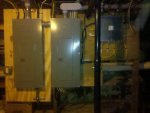Let's just say I've been taking pictures of various violations along with the particular inspector's sticker. My favorite was seeing his sticker on a panel where someone had removed a 100 amp panel and installed a 200. It wasn't a complete service replacement, just the panel. Whoever it was tied the existing #2 directly into the main in the new 200A panel. They also installed an additional ground bar and ran all the ground wires to it, but neglected to install the bond screw. It was a house with most of the electrical work surface mounted in EMT. You can imagine what might have happened had there been a fault to ground in any of that EMT.
In order to stand in front of this panel, you had to step over the wire coming through the wall that fed from the pressure tank to the well pump. The wire laid on the basement floor and ran into another basement room to where the pressure tank sat. How anyone could put a "Final Inspection" sticker on that panel is beyond me.


